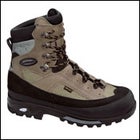As boot problems go, climbing Kilimanjaro is one of the tougher ones. As you note, youll be starting in the wet, warm jungle around the base of the 19,340-foot mountain. Youll end in sub-freezing weather, crossing snow and perhaps ice.
Lowa Tomak GTX Boots
 Lowa Tomak GTX Boots
Lowa Tomak GTX BootsIts almost a two-boot trip. The conventional wisdom is to wear waterproof” boots on the lower reaches. But whats going to be waterproof in 90-degree heat while hiking through water and mud over your boot tops? Nothing. So for that stretch, Id suggest a water shoe such as Salomon Tech Amphibian ($90; salomonsports.com), which will let plenty of water in but also let it seep out quickly. Wear them with neoprene booties, and have a change of socks so your feet can dry out.
Once you start the ascent proper, then pull out your good-quality trekking boot. Ive been wearing Scarpas new Escape GTX ($229; scarpa.com) this spring and think it would be an excellent choice. Its a sturdy, comfortable, waterproof boot (Gore-Tex lining) that has tough leather uppers and can be used with light crampons, including the clever Grivel Air Tech GSb ($140; grivel.com), which clip into a slot in the toe of the Escapes. Garmonts Vetta Plus ($224; garmont.com) would be another good choice, as would the Lowa Tomak GTX ($230; lowaboots.com). Both offer excellent support on rugged terrain, are at home on trails or snow, and can be used with crampons for all-mountain versatility. Theyd even work reasonably well lower down the mountain, although theyd be hot.
Have a great trip!
Check out ���ϳԹ���’s picks for Gear of the Year and 400-plus gear reviews in the 2007 Summer Buyer’s Guide, on newsstands now.


